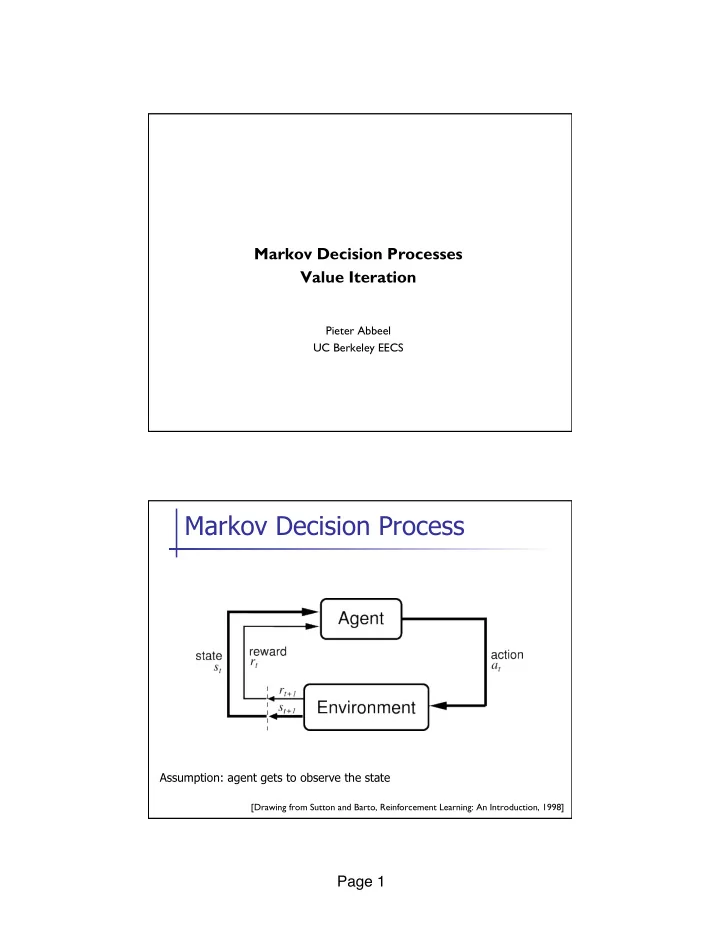

Markov Decision Processes Value Iteration Pieter Abbeel UC Berkeley EECS Markov Decision Process Assumption: agent gets to observe the state [Drawing from Sutton and Barto, Reinforcement Learning: An Introduction, 1998] Page 1 �
Markov Decision Process (S, A, T, R, H) Given S: set of states n A: set of actions n T: S x A x S x {0,1,…,H} à [0,1], T t (s,a,s’) = P( s t+1 = s’ | s t = s, a t =a) n R: S x A x S x {0, 1, …, H} à < R t (s,a,s’) = reward for ( s t+1 = s’, s t = s, a t =a) n H: horizon over which the agent will act n Goal: Find ¼ : S x {0, 1, …, H} à A that maximizes expected sum of rewards, i.e., n Examples MDP (S, A, T, R, H), goal: q Cleaning robot q Walking robot q Pole balancing q Games: tetris, backgammon q Server management q Shortest path problems q Model for animals, people Page 2 �
Canonical Example: Grid World § The agent lives in a grid § Walls block the agent’s path § The agent’s actions do not always go as planned: § 80% of the time, the action North takes the agent North (if there is no wall there) § 10% of the time, North takes the agent West; 10% East § If there is a wall in the direction the agent would have been taken, the agent stays put § Big rewards come at the end Grid Futures Deterministic Grid World Stochastic Grid World X X E N S E N S W ? W X X X X 6 Page 3 �
Solving MDPs n In an MDP, we want an optimal policy π *: S x 0:H → A n A policy π gives an action for each state for each time t=5=H t=4 t=3 t=2 t=1 t=0 n An optimal policy maximizes expected sum of rewards Contrast: In deterministic, want an optimal plan, or sequence of actions, n from start to a goal Value Iteration n Idea: n = the expected sum of rewards accumulated when starting from state s and acting optimally for a horizon of i steps n Algorithm: n Start with for all s. n For i=1, … , H Given V i *, calculate for all states s 2 S: n This is called a value update or Bellman update/back-up Page 4 �
Example Example: Value Iteration V 2 V 3 n Information propagates outward from terminal states and eventually all states have correct value estimates Page 5 �
Practice: Computing Actions n Which action should we chose from state s: n Given optimal values V*? n = greedy action with respect to V* n = action choice with one step lookahead w.r.t. V* 11 Today and forthcoming lectures Optimal control: provides general computational approach to tackle control n problems. n Dynamic programming / Value iteration n Discrete state spaces (DONE!) n Discretization of continuous state spaces n Linear systems n LQR n Extensions to nonlinear settings: n Local linearization n Differential dynamic programming n Optimal Control through Nonlinear Optimization n Open-loop n Model Predictive Control n Examples: Page 6 �
Recommend
More recommend